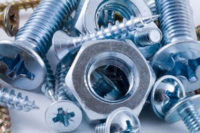Many engineers will put great thought into selecting the proper type of fastener for their design, but overlook the importance of finish. When selecting the best finish for fasteners, it is wise to consider the following factors:
- Safety. The incorrect finish could contribute to a failure of the fastened joint.
- Corrosion protection. The expected service life of the part and the service condition can determine how much corrosion a part can withstand.
- Damage resistance. Finishes can be affected by nicks and scrapes from handling and wrenching.
- Criticality of the joint. A loose joint could cause an assembly failure.
- Functionality. Certain finishes could prevent fasteners from assembling because they might fill in threads or recesses.
- Availability. Some finishes may not be readily available.
- Cost. The cost of the finish must be factored into the cost of the overall assembly.
Many exotic coatings have been developed for specific applications, and more are being produced every day. This article will not attempt to discuss all of these options, but will concentrate on the following, commonly available finishes:
- Electrodeposited zinc or “commercial” zinc.
- Electrodeposited zinc nickel.
- Mechanical zinc.
- Zinc flake.
- Hot dip galvanized.
- Epoxy electrocoat.
Safety Corrosion Protection
The main safety concern when choosing a finish for fasteners is to avoid hydrogen embrittlement (HE). During HE, or hydrogen assisted-cracking, hydrogen is introduced to the surface of a fastener and hydrogen atoms diffuse through the metal. These atoms gradually recombine to form hydrogen molecules, creating pressure from within the fastener. As this pressures increases, the fastener loses ductility, toughness and tensile strength. This can lead to catastrophic failure of the fastener.
HE can occur during various manufacturing operations or operational use—any time fasteners come into contact with hydrogen. Fasteners can become susceptible to HE during forming, coating, plating, cleaning and finishing operations. The wrong finish on a high-strength fastener can promote HE. So, what is a “high-strength fastener”?
Fasteners are considered “at risk” for HE if their hardness exceeds 380 HV on the Vickers Pyramid scale. Some examples include:
- Metric property class 12.9.
- Inch alloy-grade, socket-head cap screws.
- Case-hardened, externally threaded fasteners with machine screw thread pitch, such as thread forming screws or case-hardened serrated flange screws.
- Conical spring washers.
- Slotted or coiled spring pins.
- Retaining rings.
To eliminate the risk of HE in these fasteners, acid pickling and electro-plating should be avoided if possible. Measures may be taken to reduce risk, such as baking immediately following electroplating, but these measures can only serve to reduce the risk, and cannot completely eliminate it.
Corrosion Protection
The type of finish needed on a fastener depends on the expected service life of the fastener and the environment will it be operating in. Standard B633 from the American Society for Testing and Materials defines “service conditions” as follows:
- SC 1: Mild. Exposure to indoor atmospheres with rare condensation and subject to minimum wear or abrasion. Examples are buttons, wire goods and fasteners.
- SC 2: Moderate. Exposure mostly to dry indoor atmospheres, but subject to occasional condensation, wear or abrasion. Examples are tools, zippers, pull shelves and machine parts.
- SC 3: Severe. Exposure to condensation, perspiration, infrequent wetting by rain, and cleaners. Examples are tubular furniture, insect screens, window fittings, builders’ hardware, military hardware, washing machine parts and bicycle parts.
- SC 4: Very severe. Exposure to harsh conditions, or subject to frequent exposure to moisture, cleaners, and saline solutions, plus likely damage by denting, scratching, or abrasive wear. Examples are plumbing fixtures and pole line hardware.
The above recommendations assume a mostly natural environment. If the fasteners will be exposed to a more “industrial” environment where they will be exposed to dirt, grime and chemicals, contact Bossard for a recommendation.
Other Considerations
Hydrogen embrittlement and corrosion aren’t the only factors to consider when selecting a fastener finish.
Handling damage, such as nicks and scrapes resulting from transportation or wrenching, can be a concern for some fastener finishes. Soft or brittle finishes will begin the corrosion cycle much sooner if care is not taken in the handling and assembly of these fasteners. Finish adherence to the fastener is also a factor in maintaining good corrosion protection during handling.
Getting a joint tight and keeping it tight all depends on proper clamp load. A well designed joint with the proper clamp load should not come loose. Fastener finish is important for joints assembled using torque control, which relies on a consistent joint friction to produce a predictable and repeatable clamp load. Some finishes have known friction values while others do not. If consistent and repeatable clamp load is important to the joints survival, then coatings with a known friction should be used.
Functionality
Smaller-diameter fasteners and threaded fasteners with internal recess drives may not lend themselves well to certain finishes. The type of finish and the method of application may cause excess coating material in threads and recesses.
The following guide offers information on the most common fastener finishes to help make an informed decision on which one to use.
Electrodeposited zinc or “commercial” zinc
- Safety: hydrogen embrittlement risk for high strength fasteners.
- Corrosion protection: mild to moderate.
- Resistance to handling damage: moderate.
- Critical joints: difficult to control friction.
- Functionality: can be sued with small fasteners; no problems with threads or recesses.
- Cost: low.
- Availability: high.
- Recommended for: any fasteners with a mild to moderate corrosion protection requirement and a hardness of less than 38 on the Rockwell C scale.
Electrodeposited zinc nickel
- Safety: lower risk for hydrogen embrittlement than electroplated zinc, but still a risk.
- Corrosion protection: severe to very severe.
- Resistance to handling damage: good.
- Critical joints: difficult to control friction.
- Functionality: can be used with small fasteners; no problems with threads or recesses.
- Cost: high
- Availability: low.
- Recommended for: any fastener with severe to very severe corrosion protection requirements and a hardness of less than 38 on the Rockwell C scale. May be the best alternative for small, high-strength fasteners less than or equal to M6 if the plating process is well-controlled and baking after treatment is done properly.
Mechanical zinc
- Safety: no hydrogen embrittlement risk.
- Corrosion protection: mild to moderate.
- Resistance to handling damage: moderate.
- Critical joints: difficult to control friction.
- Functionality: poor coverage in recesses or holes; not recommended for threaded parts.
- Cost: medium to high.
- Availability: medium to low.
- Recommended for: high-strength washers and pins with a hardness of less than 38 on the Rockwell C scale. Not normally recommended for threaded fasteners.
Zinc flake
- Safety: no hydrogen embrittlement risk.
- Corrosion protection: severe to very severe.
- Resistance to handling damage: moderate.
- Critical joints: excellent friction control properties.
- Functionality: not generally recommended for threaded fasteners less than M8 or for any fastener with an internal drive feature.
- Cost: medium.
- Availability: medium.
- Recommended for: larger fasteners (greater than M6) with severe to very severe corrosion protection requirements and for joints where clamp load is critical to maintaining joint integrity.
Hot-dip galvanized
- Safety: low hydrogen embrittlement risk for high-strength fasteners; do not use for 12.9 or alloy-grade parts, as processing temperatures will temper hardness.
- Corrosion protection: severe to very severe.
- Resistance to handling damage: excellent.
- Critical joints: difficult to control friction.
- Functionality: not generally recommended for threaded fasteners less than M8 or for any fastener with an internal drive feature; retapping of nuts and female threads after coating is required.
- Cost: medium.
- Availability: medium.
- Recommended for: use in outdoor structural applications.
Epoxy electrocoat
- Safety: no hydrogen embrittlement risk.
- Corrosion protection: moderate to severe.
- Resistance to handling damage: moderate.
- Critical joints: excellent friction control properties.
- Functionality: filled threads and recesses are generally not an issue with fasteners greater than or equal to M4.
- Cost: high.
- Availability: low.
- Recommended for: thread-forming screws or screws that require a very good cosmetic black appearance.
A final consideration is the presence of hexavalent chromium, also called chrome VI or hex chrome, in a fastener finish. Many countries now regulate the use of hex chrome, which was commonly used in fastener finishes in the past and can still be found in some areas today. All of the options above are available in “hex chrome free” versions, but it is important to specify this requirement if it applies.
For more information call Bossard at 319-277-5520 or visit www.bossard.com.







